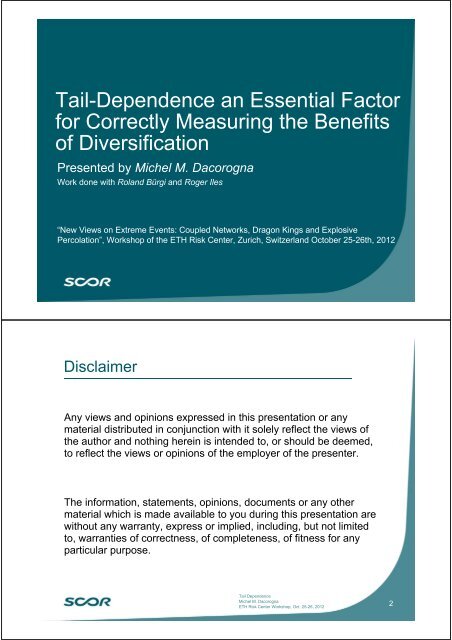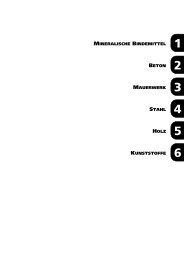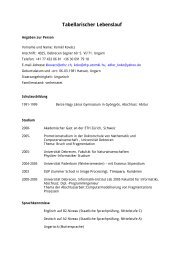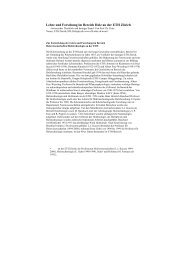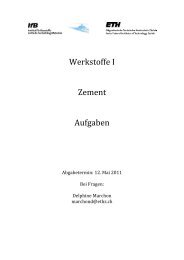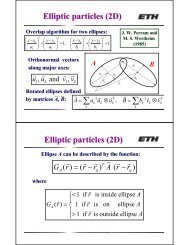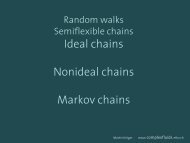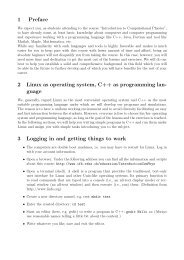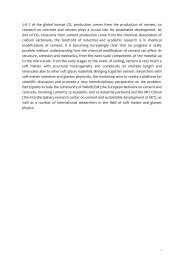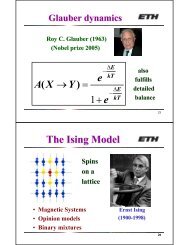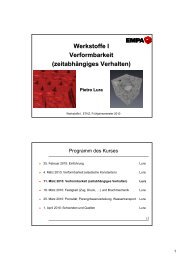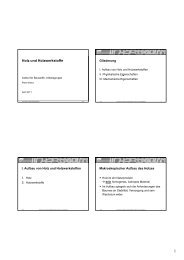Michel Dacorogna, Tail-Dependence an Essential Factor for
Michel Dacorogna, Tail-Dependence an Essential Factor for
Michel Dacorogna, Tail-Dependence an Essential Factor for
- No tags were found...
Create successful ePaper yourself
Turn your PDF publications into a flip-book with our unique Google optimized e-Paper software.
<strong>Tail</strong>-<strong>Dependence</strong> <strong>an</strong> <strong>Essential</strong> <strong>Factor</strong><strong>for</strong> Correctly Measuring the Benefitsof DiversificationPresented by <strong>Michel</strong> M. <strong>Dacorogna</strong>Work done with Rol<strong>an</strong>d Bürgi <strong>an</strong>d Roger Iles“New Views on Extreme Events: Coupled Networks, Dragon Kings <strong>an</strong>d ExplosivePercolation”, Workshop of the ETH Risk Center, Zurich, Switzerl<strong>an</strong>d October 25-26th, 2012DisclaimerAny views <strong>an</strong>d opinions expressed in this presentation or <strong>an</strong>ymaterial distributed in conjunction with it solely reflect the views ofthe author <strong>an</strong>d nothing herein is intended to, or should be deemed,to reflect the views or opinions of the employer of the presenter.The in<strong>for</strong>mation, statements, opinions, documents or <strong>an</strong>y othermaterial which is made available to you during this presentation arewithout <strong>an</strong>y warr<strong>an</strong>ty, express or implied, including, but not limitedto, warr<strong>an</strong>ties of correctness, of completeness, of fitness <strong>for</strong> <strong>an</strong>yparticular purpose.<strong>Tail</strong> <strong>Dependence</strong><strong>Michel</strong> M. <strong>Dacorogna</strong>ETH Risk Center Workshop, Oct. 25-26, 20122
AcknowledgementThis work is based on a team ef<strong>for</strong>t by:Rol<strong>an</strong>d Bürgi who programmed the whole <strong>an</strong>alysis <strong>an</strong>ddeveloped a method to generate hierarchical multivariatedistributions with copulasRoger IlesAnd <strong>Michel</strong> <strong>Dacorogna</strong><strong>Tail</strong> <strong>Dependence</strong><strong>Michel</strong> M. <strong>Dacorogna</strong>ETH Risk Center Workshop, Oct. 25-26, 20123Agenda1 Risk-Adjusted Capital <strong>an</strong>d dependence2 Description of the model3 Influence of the number of observations on calibration4 Influence of dependence structure <strong>an</strong>d models5 Ways to model the dependence6 Conclusion<strong>Tail</strong> <strong>Dependence</strong><strong>Michel</strong> M. <strong>Dacorogna</strong>ETH Risk Center Workshop, Oct. 25-26, 20124
Determining Risk-Adjusted CapitalThe Risk-Adjusted capital (RAC) of <strong>an</strong> insur<strong>an</strong>ce comp<strong>an</strong>y isevaluated on the basis of a qu<strong>an</strong>titative model of its differentrisksWe first need to identify the various sources of risk. Oneusually distinguishes four large risk categories:1. Underwriting risk (or liability risk),2. Investment risk (or asset risk),3. Credit risk (or risk of default),4. Operational riskGenerally insur<strong>an</strong>ce comp<strong>an</strong>ies have the know-how tom<strong>an</strong>age <strong>an</strong>d model their liability risk <strong>an</strong>d are able to modelthe next two categories as well using st<strong>an</strong>dard fin<strong>an</strong>ce models<strong>Tail</strong> <strong>Dependence</strong><strong>Michel</strong> M. <strong>Dacorogna</strong>ETH Risk Center Workshop, Oct. 25-26, 20125<strong>Dependence</strong> Between Risks is KeyRisk Diversification reduces a comp<strong>an</strong>y’s need <strong>for</strong> Risk-Adjusted capital. This is key to both insur<strong>an</strong>ce <strong>an</strong>d investments.However, risks are rarely completely independent:• Stock market crashes are usually not limited to one stock market.• Certain lines of business are affected by economic cycles, likeaviation, credit & surety or life insur<strong>an</strong>ces.• Motor insur<strong>an</strong>ce is also correlated to motor liability insur<strong>an</strong>ce <strong>an</strong>dboth will vary during economic cycles.• Big catastrophes c<strong>an</strong> produce claims in various lines of business.<strong>Dependence</strong> between risks reduces the benefits ofdiversification.The influence of dependence on the aggregated RAC is thuscrucial <strong>an</strong>d needs to be carefully <strong>an</strong>alyzed.<strong>Tail</strong> <strong>Dependence</strong><strong>Michel</strong> M. <strong>Dacorogna</strong>ETH Risk Center Workshop, Oct. 25-26, 20126
Influence of Correlation on RACLet us take the same risk twice (lognormally distributed, m=10 <strong>an</strong>ds=1) <strong>an</strong>d bundle them in a portfolio.Let us vary the correlation between the risks from 0 to 0.90.Here are the various diversification benefits, D, in percent:RACPD 1 RACwhere RAC P is theportfolio RAC <strong>an</strong>dRAC i are the RAC’sof the various risks.iiDiversification Benefits40%35%30%25%20%15%10%5%0%0 0.3 0.6 0.9Correlation Coefficient<strong>Tail</strong> <strong>Dependence</strong><strong>Michel</strong> M. <strong>Dacorogna</strong>ETH Risk Center Workshop, Oct. 25-26, 20127<strong>Dependence</strong> is not Always LinearWe have learned to model dependence through linear correlation.The whole modern portfolio theory is based on correlation.Often dependence increases when diversification is most needed:in case of stress. It is thus non-linear.It is possible to use the copulas instead of linear correlation tomodel dependences (copula=“generalized dependence structure”as opposed to “linear dependence”=correlation).The dependence structure will influence greatly the needs <strong>for</strong> RAC<strong>an</strong>d the diversification benefits one c<strong>an</strong> obtain.In the following, we present a statistical study of variousdependence structures <strong>an</strong>d their influence on diversification.<strong>Tail</strong> <strong>Dependence</strong><strong>Michel</strong> M. <strong>Dacorogna</strong>ETH Risk Center Workshop, Oct. 25-26, 20128
Agenda1 Risk-Adjusted Capital <strong>an</strong>d dependence2 Description of the model3 Influence of the number of observations on calibration4 Influence of dependence structure <strong>an</strong>d models5 Ways to model the dependence6 Conclusion<strong>Tail</strong> <strong>Dependence</strong><strong>Michel</strong> M. <strong>Dacorogna</strong>ETH Risk Center Workshop, Oct. 25-26, 20129Aim & MethodAimTo show the difficulty of statistically estimating the rightdependenceTo illustrate the import<strong>an</strong>ce of using the correct Copuladependence when modeling dependent marginal distributionsTo <strong>an</strong>alyze the influence of the dependence structure on thediversification benefitsMethodStochastic simulations <strong>an</strong>d fitting of various dependence modelsTo reproduce the behavior of the hierarchical dependence treethat is correlated through 3 Clayton copulas<strong>Tail</strong> <strong>Dependence</strong><strong>Michel</strong> M. <strong>Dacorogna</strong>ETH Risk Center Workshop, Oct. 25-26, 201210
Basics of the Model (1/2)We use lognormal distributions as the basic risk of our portfolio:1f x e x2x2(ln x)22( ) 0; 0We choose m=10 <strong>an</strong>d s=1 <strong>for</strong> all the risks*We w<strong>an</strong>t a simple risk model to study the influence of thedependence structure <strong>an</strong>d functionThe basic risk is then used in various dependenceconfigurations <strong>an</strong>d with different dependence functionsWe choose a configuration that we assume to be the real one,which we fit with various other models* Close to the parameters proposed by M. Bagarry For modeling insur<strong>an</strong>ce risks.<strong>Tail</strong> <strong>Dependence</strong><strong>Michel</strong> M. <strong>Dacorogna</strong>ETH Risk Center Workshop, Oct. 25-26, 201211Basics of the Model (2/2)RAC is calculated with Expected Shortfall (tVaR) <strong>for</strong> variousrisk toler<strong>an</strong>ce levels. We summarize the results <strong>for</strong> the 1/100tVaR.This is the risk measure used in the Swiss Solvency Test <strong>an</strong>dat the basis of our own capital allocation modelWe also compute the VaR at 1/200 as it is the risk measurerecommended by Solvency II <strong>an</strong>d we compare both results<strong>Tail</strong> <strong>Dependence</strong><strong>Michel</strong> M. <strong>Dacorogna</strong>ETH Risk Center Workshop, Oct. 25-26, 201212
The Lognormal DistributionLognormal distribution is the singletailedprobability distribution of <strong>an</strong>yr<strong>an</strong>dom variable whose logarithm isnormally distributed.Lognormal Probability DensityFunction2(ln x)122f( x) e x0; 02xLognormal Cumulative DistributionFunctionlnx F( x) x0; 0 <strong>Tail</strong> <strong>Dependence</strong><strong>Michel</strong> M. <strong>Dacorogna</strong>ETH Risk Center Workshop, Oct. 25-26, 201213Hierarchical <strong>Dependence</strong> TreeBase scenario: Hierarchical <strong>Dependence</strong> Tree*• Hierarchy of 4 related marginal distributions• Using signific<strong>an</strong>tly different dependence parameters QComp<strong>an</strong>y LevelClayton CopulaΘ=1 This is not the usual hierarchical Archimede<strong>an</strong>copula of Savu <strong>an</strong>d Trede 2006 but rather adependence on the aggregateProperty FRClayton CopulaΘ=2Property DEClayton CopulaΘ=3Risk <strong>Factor</strong> 1e.g. Fire, FRRisk <strong>Factor</strong> 2e.g. Nat Cat, FRRisk <strong>Factor</strong> 3e.g. Fire, DERisk <strong>Factor</strong> 4e.g. Nat Cat, DE<strong>Tail</strong> <strong>Dependence</strong><strong>Michel</strong> M. <strong>Dacorogna</strong>ETH Risk Center Workshop, Oct. 25-26, 201214
Archimede<strong>an</strong> Copula: Clayton Copulaθ = 0.1 θ = 0.5 θ = 1.0 θ = 2.0The Clayton Copula CDF is definedby:With a Generator of the Copula:Diversification Benefits35%30%25%20%15%10%5%The Clayton copula is Archimede<strong>an</strong>0%0.1 0.5 1.0 2.0Correlation Coefficient<strong>Tail</strong> <strong>Dependence</strong><strong>Michel</strong> M. <strong>Dacorogna</strong>ETH Risk Center Workshop, Oct. 25-26, 201215Archimede<strong>an</strong> Copula: Gumbel Copulaθ = 1.0 θ = 1.5 θ = 2.0 θ = 3.0The Gumbel Copula CDF is definedby:where the Generator of the Copula isgiven by:The Gumbel copula is Archimede<strong>an</strong>Diversification Benefits40%35%30%25%20%15%10%5%0%1.0 1.5 2.0 3.0Correlation Coefficient<strong>Tail</strong> <strong>Dependence</strong><strong>Michel</strong> M. <strong>Dacorogna</strong>ETH Risk Center Workshop, Oct. 25-26, 201216
Elliptical Copula: R<strong>an</strong>k Correlationm1 m2m1 1 0m2 0 1m1 m2m1 1 0.3m2 0.3 1m1 m2m1 1 0.6m2 0.6 1m1 m2m1 1 0.9m2 0.9 1The multivariate Normal distribution copula has a matrix as a parameter.The PDF of a Normal copula is:where,is the inverse of the CDF N(0,1) <strong>an</strong>d I is theidentity matrix of size n.The r<strong>an</strong>k correlation is <strong>an</strong> elliptical copula.<strong>Tail</strong> <strong>Dependence</strong><strong>Michel</strong> M. <strong>Dacorogna</strong>ETH Risk Center Workshop, Oct. 25-26, 201217Elliptical Copula: Student’s TThe multivariate Student’s T distribution copula also has a matrix as a parameter. ThePDF of a Student’s T copula is:Where,is the inverse of the CDF of the univariate T distribution withn degrees of freedomThe Student’s T copula is <strong>an</strong> elliptical copulaEffects of matrix parameter ch<strong>an</strong>ges:n =3m1 m2m1 1 0m2 0 1m1 m2m1 1 0.3m2 0.3 1m1 m2m1 1 0.6m2 0.6 1m1 m2m1 1 0.9m2 0.9 1<strong>Tail</strong> <strong>Dependence</strong><strong>Michel</strong> M. <strong>Dacorogna</strong>ETH Risk Center Workshop, Oct. 25-26, 201218
Student’s TEffect of ch<strong>an</strong>ging degrees of freedom:m1 m2m1 1 0.6m2 0.6 1n = 1n = 3 n = 6 n = 9Diversification benefits from varying the Diversification benefits from varying thematrix parameter (3 degrees of freedom): degrees of freedom:35%16%30%14%Diversification Benefits25%20%15%10%Diversification Benefits12%10%8%6%4%5%2%0%0 0.3 0.6 0.9Matrix Parameter0%1 3 6 9Degrees of Freedom<strong>Tail</strong> <strong>Dependence</strong><strong>Michel</strong> M. <strong>Dacorogna</strong>ETH Risk Center Workshop, Oct. 25-26, 201219Value versus R<strong>an</strong>k ScatterSignific<strong>an</strong>ce of Value versusR<strong>an</strong>k ScatterR<strong>an</strong>k ScatterValue ScatterValue scatter is used tocharacterize the spread ofthe marginal distributionsΘ=2R<strong>an</strong>k scatter shows theunderlying dependencebetween the marginalsΘ=1For the purpose of <strong>an</strong>alysingdependence we shall displayonly r<strong>an</strong>k scatter from hereonΘ=3<strong>Tail</strong> <strong>Dependence</strong><strong>Michel</strong> M. <strong>Dacorogna</strong>ETH Risk Center Workshop, Oct. 25-26, 201220
Agenda1 Risk-Adjusted Capital <strong>an</strong>d dependence2 Description of the model3 Influence of the number of observations on calibration4 Influence of dependence structure <strong>an</strong>d models5 Ways to model the dependence6 Conclusion<strong>Tail</strong> <strong>Dependence</strong><strong>Michel</strong> M. <strong>Dacorogna</strong>ETH Risk Center Workshop, Oct. 25-26, 201221Fitting ScenariosScenarios: We fit the original dependence using the followingcopula scenarios <strong>an</strong>d calculate the Diversification <strong>an</strong>d RACHierarchical <strong>Dependence</strong>• Gumbel Hierarchy• R<strong>an</strong>k Correlation Hierarchy• Student-T HierarchyFlat <strong>Dependence</strong>• Clayton Flat• Gumbel Flat• R<strong>an</strong>k Correlation Flat• Student-T FlatThe base scenario is the hierarchical Clayton scenario presentedbe<strong>for</strong>e<strong>Tail</strong> <strong>Dependence</strong><strong>Michel</strong> M. <strong>Dacorogna</strong>ETH Risk Center Workshop, Oct. 25-26, 201222
Fitting: Hierarchical ScenarioFitting ScenarioThe Clayton Hierarchical Tree is fit by using the same structure* correlatedwith different copulas <strong>for</strong> each scenarioThe results are then displayed on a r<strong>an</strong>k-scatter plot <strong>an</strong>d throughdiversification <strong>an</strong>d RAC value calculationComp<strong>an</strong>y Level This is not the usual hierarchical Archimede<strong>an</strong>copula of Savu <strong>an</strong>d Trede 2006 but rather adependence on the aggregateAggregate <strong>Dependence</strong>CopulaMarginal <strong>Dependence</strong>CopulaMarginal <strong>Dependence</strong>CopulaRisk <strong>Factor</strong> 1e.g. Fire, FRRisk <strong>Factor</strong> 2e.g. Nat Cat, FRRisk <strong>Factor</strong> 3e.g. Fire, DERisk <strong>Factor</strong> 4e.g. Nat Cat, DE<strong>Tail</strong> <strong>Dependence</strong><strong>Michel</strong> M. <strong>Dacorogna</strong>ETH Risk Center Workshop, Oct. 25-26, 201223Fitting: Flat ScenarioBusiness Scenario:Small comp<strong>an</strong>y, with a small amount of business in eachbasket baskets are merged.All marginals modeled by one copulaComp<strong>an</strong>y LevelMarginal <strong>Dependence</strong>CopulaRisk <strong>Factor</strong> 1e.g. Fire, FRRisk <strong>Factor</strong> 2e.g. Nat Cat, FRRisk <strong>Factor</strong> 3e.g. Fire, DERisk <strong>Factor</strong> 4e.g. Nat Cat, DE<strong>Tail</strong> <strong>Dependence</strong><strong>Michel</strong> M. <strong>Dacorogna</strong>ETH Risk Center Workshop, Oct. 25-26, 201224
Estimation of CopulasThe following estimation methods were used:Clayton / Gumbel:Maximum likelihood estimation, i.e. estimates the parameter by maximizing the loglikelihoodfunction LMLF log(c ( x )), where c( xii) is the copula density of point iiR<strong>an</strong>k Correlation:Estimate the Spearm<strong>an</strong>’s correlation R<strong>an</strong>kCorr(X , Y ) 12E[(FX( X ) 0.5)( FY( Y ) 0.5)]<strong>for</strong> each pair X <strong>an</strong>d Y. The correlation matrix <strong>for</strong> the Gauss copula c<strong>an</strong> be derived as ij 2sinR<strong>an</strong>kCorr( Xi,Xj) 6Student’s T:2Estimate the Kendall ( X , Y) sign[( Xi X j)( Yi Yj)]N( N 1)ij The correlation matrix c<strong>an</strong> be derived as ij sinij 2 The degree of freedom is estimated with maximum likelihood.<strong>Tail</strong> <strong>Dependence</strong><strong>Michel</strong> M. <strong>Dacorogna</strong>ETH Risk Center Workshop, Oct. 25-26, 201225Fitting Convergence Plots: MethodologyThe Fitting Convergence Plots are drawn using the following methodology:1. Simulate N observations from the reference scenario2. Fit the corresponding scenario to the N observations3. Resample the fitted scenario with 50’000 observations4. Measure the diversification gainRepeat 10 timesThe me<strong>an</strong> <strong>an</strong>d st<strong>an</strong>dard deviation of the 10 runs per point are calculated.• The fitting convergence plots show the me<strong>an</strong> ± one st<strong>an</strong>darddeviation <strong>for</strong> each N.• The fitting error plots show the st<strong>an</strong>dard deviation <strong>for</strong> each N.<strong>Tail</strong> <strong>Dependence</strong><strong>Michel</strong> M. <strong>Dacorogna</strong>ETH Risk Center Workshop, Oct. 25-26, 201226
Convergence of Fits <strong>for</strong> 2 MarginalsStarting from Clayton = 1Theoretical Diversification Gain<strong>Tail</strong> <strong>Dependence</strong><strong>Michel</strong> M. <strong>Dacorogna</strong>ETH Risk Center Workshop, Oct. 25-26, 201227St<strong>an</strong>dard Deviations of the Fits <strong>for</strong> 2 MarginalsStarting from Clayton = 1<strong>Tail</strong> <strong>Dependence</strong><strong>Michel</strong> M. <strong>Dacorogna</strong>ETH Risk Center Workshop, Oct. 25-26, 201228
Convergence of the Fits <strong>for</strong> 4 MarginalsTheoretical Diversification Gain<strong>Tail</strong> <strong>Dependence</strong><strong>Michel</strong> M. <strong>Dacorogna</strong>ETH Risk Center Workshop, Oct. 25-26, 201229St<strong>an</strong>dard Deviation of the Fits <strong>for</strong> 4 Marginals<strong>Tail</strong> <strong>Dependence</strong><strong>Michel</strong> M. <strong>Dacorogna</strong>ETH Risk Center Workshop, Oct. 25-26, 201230
Number of Observations mattersless th<strong>an</strong> <strong>Dependence</strong> ModelsWe see that the elliptical copulas keep a systematic biaswhatever the number of observationsThe Archimede<strong>an</strong> copulas fit much better the theoretical valuewith Clayton doing it the best, as expectedThe error of the estimation decreases with the number ofobservations <strong>an</strong>d remains at a certain level even with 50’000observationsThe structure of the dependence (hierarchical or flat) does notaffect really the diversification benefit with hierarchical beingslightly better <strong>for</strong> Archimede<strong>an</strong> copulasWhen the dependence is asymmetric (as it is usually the case<strong>for</strong> insur<strong>an</strong>ce liabilities), it is difficult to model it with symmetricdependence models (use asymmetric copulas)<strong>Tail</strong> <strong>Dependence</strong><strong>Michel</strong> M. <strong>Dacorogna</strong>ETH Risk Center Workshop, Oct. 25-26, 201231Agenda1 Risk-Adjusted Capital <strong>an</strong>d dependence2 Description of the model3 Influence of the number of observations on calibration4 Influence of dependence structure <strong>an</strong>d models5 Ways to model the dependence6 Conclusion<strong>Tail</strong> <strong>Dependence</strong><strong>Michel</strong> M. <strong>Dacorogna</strong>ETH Risk Center Workshop, Oct. 25-26, 201232
Results of Fit: Clayton FlatAs expected, the two strongerdependences are reduced <strong>an</strong>d the weakerdependence is strengthened.Fit: = 1.2The RAC <strong>an</strong>d diversification gain are evenslightly more conservative. The error isalmost negligible.Clayton FlatClayton HierarchyM3,M4 Θ=2The Q/Q plot shows good agreement ofthe models.Clayton ClaytonHierarchy FlatExpected 145‘550 145‘407Std Dev 172‘587 172‘948LH Div. Gain 9.56% 9.14%RH VaR 1‘070‘462 1‘078‘190RH Shortfall 1‘248‘146 1‘251‘138RH RAC 1‘102‘595 1‘105‘731RH Div. Gain 8.17% 7.73%Aggregate Θ=1M5, M6 Θ=3<strong>Tail</strong> <strong>Dependence</strong><strong>Michel</strong> M. <strong>Dacorogna</strong>ETH Risk Center Workshop, Oct. 25-26, 201233Results of Fit: Gumbel HierarchyAs the Clayton, the Gumbel copula is <strong>an</strong>Archimede<strong>an</strong> Copula.Gumbel HierarchyClayton HierarchyGumbel represents the Clayton well in the tailregion <strong>for</strong> all 3 distributionsIn contrast to the Clayton, the Gumbelintroduces a dependence also in the lowertail.RAC is slightly underestimatedThe Q/Q shows fair similarity of the twoCopula types.ClaytonHierarchyGumbelHierarchyExpected 145‘550 144‘964Std Dev 172‘587 164‘507LH Div. Gain 9.56% 5.70%RH VaR 1‘070‘462 1‘021‘144RH Shortfall 1‘248‘146 1‘195‘423RH RAC 1‘102‘595 1‘050‘458RH Div. Gain 8.17% 11.73%Θ=2.07Θ=1.54Θ=2.61M3,M4 Θ=2Aggregate Θ=1M5, M6 Θ=3<strong>Tail</strong> <strong>Dependence</strong><strong>Michel</strong> M. <strong>Dacorogna</strong>ETH Risk Center Workshop, Oct. 25-26, 201234
Results of Fit: Gumbel FlatThe coupling on both ends is again visibleGumbel FlatClayton HierarchyOverall, the fit of the tail region is stillreasonableSince the dependence of the lower tailreduces the tail dependence in the uppertail in the fit, the RAC is slightlyunderestimated.The Q/Q plot still shows a reasonablygood agreement between the copulas.Clayton GumbelHierarchy FlatExpected 145‘550 145‘063Std Dev 172‘587 162‘936LH Div. Gain 9.56% 7.20%RH VaR 1‘070‘462 1‘028‘533RH Shortfall 1‘248‘146 1‘188‘803RH RAC 1‘102‘595 1‘043‘740RH Div. Gain 8.17% 12.69%M3,M4 Θ=2Aggregate Θ=1M5, M6 Θ=3<strong>Tail</strong> <strong>Dependence</strong><strong>Michel</strong> M. <strong>Dacorogna</strong>ETH Risk Center Workshop, Oct. 25-26, 201235Results of Fit: R<strong>an</strong>k Correlation HierarchyR<strong>an</strong>k correlation is symmetric strongcorrelation also <strong>for</strong> the lower tail.R<strong>an</strong>k Corr. HierarchyClayton HierarchyThe upper tail is much less pointed th<strong>an</strong><strong>for</strong> the Clayton.The RAC is subst<strong>an</strong>tially underestimated.The diversification gain is unrealisticallyhigh.The Q/Q plot shows the deviation in thetails.ClaytonHierarchyR<strong>an</strong>kCorr.HierarchyExpected 145‘550 145‘464Std Dev 172‘587 146‘133LH Div. Gain 9.56% 3.90%RH VaR 1‘070‘462 877‘052RH Shortfall 1‘248‘146 990‘103RH RAC 1‘102‘595 844‘639RH Div. Gain 8.17% 30.33%= 0.7= 0.5 = 0.8M3,M4 Θ=2Aggregate Θ=1M5, M6 Θ=3<strong>Tail</strong> <strong>Dependence</strong><strong>Michel</strong> M. <strong>Dacorogna</strong>ETH Risk Center Workshop, Oct. 25-26, 201236
Results of Fit: R<strong>an</strong>k Correlation FlatThe flat r<strong>an</strong>k correlation produces alsostthe same results as the hierarchical one.R<strong>an</strong>k Corr. FlatClayton HierarchyThis c<strong>an</strong> be seen in all graphics as well asthe RAC calculations. i, j1.000.700.450.460.701.000.450.460.450.451.000.800.460.460.801.00ClaytonHierarchyR<strong>an</strong>kCorr.Expected 145‘550 145‘293Std Dev 172‘587 144‘448LH Div. Gain 9.56% 3.98%RH VaR 1‘070‘462 870‘389RH Shortfall 1‘248‘146 977‘617RH RAC 1‘102‘595 832‘324RH Div. Gain 8.17% 30.70%M3,M4 Θ=2Aggregate Θ=1M5, M6 Θ=3<strong>Tail</strong> <strong>Dependence</strong><strong>Michel</strong> M. <strong>Dacorogna</strong>ETH Risk Center Workshop, Oct. 25-26, 201237Results of Fit: Student’s T HierarchyAs the R<strong>an</strong>k Correlation, the Student’s Tcopula is <strong>an</strong> elliptical copula.The Student‘s T has one parameter moreper dependence th<strong>an</strong> the R<strong>an</strong>k Correlation<strong>Dependence</strong> is symmetric, i.e. alsointroduced in the lower tail.RAC is subst<strong>an</strong>tially underestimated.Unrealistically high diversification gainThe Q/Q plot looks similar as <strong>for</strong> the R<strong>an</strong>kCorrelation.ClaytonHierarchyStudent THierarchyExpected 145‘550 145‘088Std Dev 172‘587 150‘290LH Div. Gain 9.56% 3.05%RH VaR 1‘070‘462 909‘335RH Shortfall 1‘248‘146 1‘045‘099RH RAC 1‘102‘595 900‘012RH Div. Gain 8.17% 25%= 0.81; = 4 = 0.51; = 9 = 0.71; = 6Student-T HierarchyClayton Hierarchy<strong>Tail</strong> <strong>Dependence</strong><strong>Michel</strong> M. <strong>Dacorogna</strong>ETH Risk Center Workshop, Oct. 25-26, 201238M3,M4 Θ=2Aggregate Θ=1M5, M6 Θ=3
Results of Fit: Student-T FlatSimilar to Student-T HierarchyStudent-T FlatClayton HierarchyHas one parameter more th<strong>an</strong> the R<strong>an</strong>kCorrelation Slightly betterHas two parameters less th<strong>an</strong> thehierarchical Student‘s T Slightly worseM3,M4 Θ=21.000.71 0.45 0.460.711.00 0.45 0.46i, j0.45 0.45 1.00 0.81 = 100.460.46 0.81 1.00 Clayton Student's THierarchyExpected 145‘550 144‘980Std Dev 172‘587 150‘838LH Div. Gain 9.56% 3.20%RH VaR 1‘070‘462 901‘757RH Shortfall 1‘248‘146 1‘043‘301RH RAC 1‘102‘595 898‘322RH Div. Gain 8.17% 25.42%Aggregate Θ=1M5, M6 Θ=3<strong>Tail</strong> <strong>Dependence</strong><strong>Michel</strong> M. <strong>Dacorogna</strong>ETH Risk Center Workshop, Oct. 25-26, 201239Summary of the Statistical ResultsStatisticalResults250,000 simulationsClaytonHierarchyClaytonFlatGumbelHierarchyGumbelFlatR<strong>an</strong>kCorr.R<strong>an</strong>k Corr. Student's T Student'sHierarchyTHierarchyExpected 145‘550 145‘407 144‘965 145‘063 145‘293 145‘464 144‘980 145‘088Std Dev 172‘587 172‘948 164‘507 162‘936 144‘448 146‘133 150‘838 150‘290LH Div. Gain 9.56% 9.14% 5.70% 7.20% 3.98% 3.90% 3.20% 3.05%RH VaR 1‘070‘462 1‘078‘190 1‘021‘144 1‘028‘533 870‘389 877‘052 901‘757 909‘335RH Shortfall 1‘248‘146 1‘251‘138 1‘195‘423 1‘188‘803 977‘617 990‘103 1‘043‘301 1‘045‘099RH RAC 1‘102‘595 1‘105‘731 1‘050‘458 1‘043‘740 832‘324 844‘639 898‘322 900‘012RH Div. Gain 8.17% 7.73% 11.73% 12.69% 30.70% 30.33% 25.42% 25%<strong>Tail</strong> <strong>Dependence</strong><strong>Michel</strong> M. <strong>Dacorogna</strong>ETH Risk Center Workshop, Oct. 25-26, 201240
<strong>Dependence</strong> Model mattersmore th<strong>an</strong> <strong>Dependence</strong> StructureWe see that the elliptical copulas do not improve by movingfrom a flat structure to a hierarchical one.The Gumbel copula slightly improves if used in the appropriatedependence structure.The elliptical copulas grossly underestimate the risk <strong>an</strong>d showundue diversification benefits.Gumbel copula is able to produce reasonable results on the lefttail but also emphasizes a dependence on the right tail thatdoes not exist in the benchmark model.<strong>Tail</strong> <strong>Dependence</strong><strong>Michel</strong> M. <strong>Dacorogna</strong>ETH Risk Center Workshop, Oct. 25-26, 201241Underestimation starts alreadywith weak dependence<strong>Tail</strong> <strong>Dependence</strong><strong>Michel</strong> M. <strong>Dacorogna</strong>ETH Risk Center Workshop, Oct. 25-26, 201242
Agenda1 Risk-Adjusted Capital <strong>an</strong>d dependence2 Description of the model3 Influence of the number of observations on calibration4 Influence of dependence structure <strong>an</strong>d models5 Ways to model the dependence6 Conclusion<strong>Tail</strong> <strong>Dependence</strong><strong>Michel</strong> M. <strong>Dacorogna</strong>ETH Risk Center Workshop, Oct. 25-26, 201243How to Estimate <strong>Dependence</strong>s?<strong>Dependence</strong>s c<strong>an</strong> hardly be described by one number such as a linearcorrelation coefficient.We just saw that it is possible to use the copulas to model dependences.In insur<strong>an</strong>ce, there is often not enough liability data to estimate thecopulas.Nevertheless, copulas c<strong>an</strong> be used to tr<strong>an</strong>slate <strong>an</strong> opinion aboutdependences in the portfolio into a model:Part III, SCOR Switzerl<strong>an</strong>d’s internal modelSelect a copula with <strong>an</strong> appropriate shape• increased dependences in the tail– this feature is observable in historic insur<strong>an</strong>ce loss dataTry to estimate conditional probabilities by asking questions such as“What if a particular risk turned very bad?”• Think about adverse scenarios in the portfolio• Look at causal relations between risks<strong>Tail</strong> <strong>Dependence</strong><strong>Michel</strong> M. <strong>Dacorogna</strong>ETH Risk Center Workshop, Oct. 25-26, 201244
Strategy <strong>for</strong> modeling dependencesUsing the knowledge of the underlying business, develop ahierarchical model <strong>for</strong> dependences in order to reduce theparameter space <strong>an</strong>d describe more accurately the mainsources of dependent behaviorWherever we know a causal dependence, we model it explicitlySystematically usage of non-symmetric copulas: ClaytoncopulaWherever there is enough data, we calibrate statistically theparametersIn absence of data, we use stress scenarios <strong>an</strong>d expertopinions to estimate conditional probabilities (PrObEx)<strong>Tail</strong> <strong>Dependence</strong><strong>Michel</strong> M. <strong>Dacorogna</strong>ETH Risk Center Workshop, Oct. 25-26, 201245Combining three sources of in<strong>for</strong>mation(Up to) three sources of in<strong>for</strong>mation c<strong>an</strong> be combined (PrObEx*):PriorA prior density, e.g. from previous years or from regulators.ObservationExpertsN independent observations of joint realizations from .The set of observation is denoted byK experts, each providing one point estimate of .The set of expert assessments is denoted by We replace the prior density by a posterior density of given <strong>an</strong>dBayes‘ Theorem leads to the relation:*) See SCOR Paper no 10, on http://scor.com/images/stories/pdf/scorpapers/scorpapers10_en.pdf<strong>Tail</strong> <strong>Dependence</strong><strong>Michel</strong> M. <strong>Dacorogna</strong>ETH Risk Center Workshop, Oct. 25-26, 201246
Our modelWe make the following assumptions:The expert assessments <strong>an</strong>d the observations are independentThe observations are independentThe experts <strong>for</strong>m their opinion independently of each otherUnder these assumptions, the posterior distribution of the value of the dependence measure reads as:PriorObservationExpertsThrough this posterior distribution we c<strong>an</strong>:Estimate , e.g. via .Assess the uncertainty of our estimate, e.g. via .<strong>Tail</strong> <strong>Dependence</strong><strong>Michel</strong> M. <strong>Dacorogna</strong>ETH Risk Center Workshop, Oct. 25-26, 201247An illustrative exampleThe best estimate using all in<strong>for</strong>mation is then:<strong>Tail</strong> <strong>Dependence</strong><strong>Michel</strong> M. <strong>Dacorogna</strong>ETH Risk Center Workshop, Oct. 25-26, 201248
Agenda1 Risk-Adjusted Capital <strong>an</strong>d dependence2 Description of the model3 Influence of the number of observations on calibration4 Influence of dependence structure <strong>an</strong>d models5 Ways to model the dependence6 Conclusion<strong>Tail</strong> <strong>Dependence</strong><strong>Michel</strong> M. <strong>Dacorogna</strong>ETH Risk Center Workshop, Oct. 25-26, 201249SummaryNeglecting dependences leads to a gross underestimation of the Risk-Adjusted capitalNeglecting the non-linearity of dependences leads also to <strong>an</strong>overestimation of the diversification benefits<strong>Dependence</strong>s in insur<strong>an</strong>ce risks are usually asymmetric: stronger onthe negative side th<strong>an</strong> on the positive oneA suitable copula to model those type of dependences is the ClaytoncopulaTo get the right diversification benefit the choice of the rightdependence model matters mostWith a relatively modest number of data it is possible to obtain areasonable estimate of the diversification benefit with Clayton copulaEspecially when combined with expert opinions on stress tests(PrObEx)<strong>Tail</strong> <strong>Dependence</strong><strong>Michel</strong> M. <strong>Dacorogna</strong>ETH Risk Center Workshop, Oct. 25-26, 201250
Further researchDevelop the empirical exploration of dependencesAnalyze retarded dependences: causal relationsPursue the study of the influence of the hierarchical tree ontotal RAC with more br<strong>an</strong>ches <strong>an</strong>d depthApply the PrObEx methodology <strong>for</strong> all the modeled insur<strong>an</strong>cerisksExplore <strong>an</strong>alytical solutions <strong>for</strong> risk aggregation with copuladependence<strong>Tail</strong> <strong>Dependence</strong><strong>Michel</strong> M. <strong>Dacorogna</strong>ETH Risk Center Workshop, Oct. 25-26, 201251


